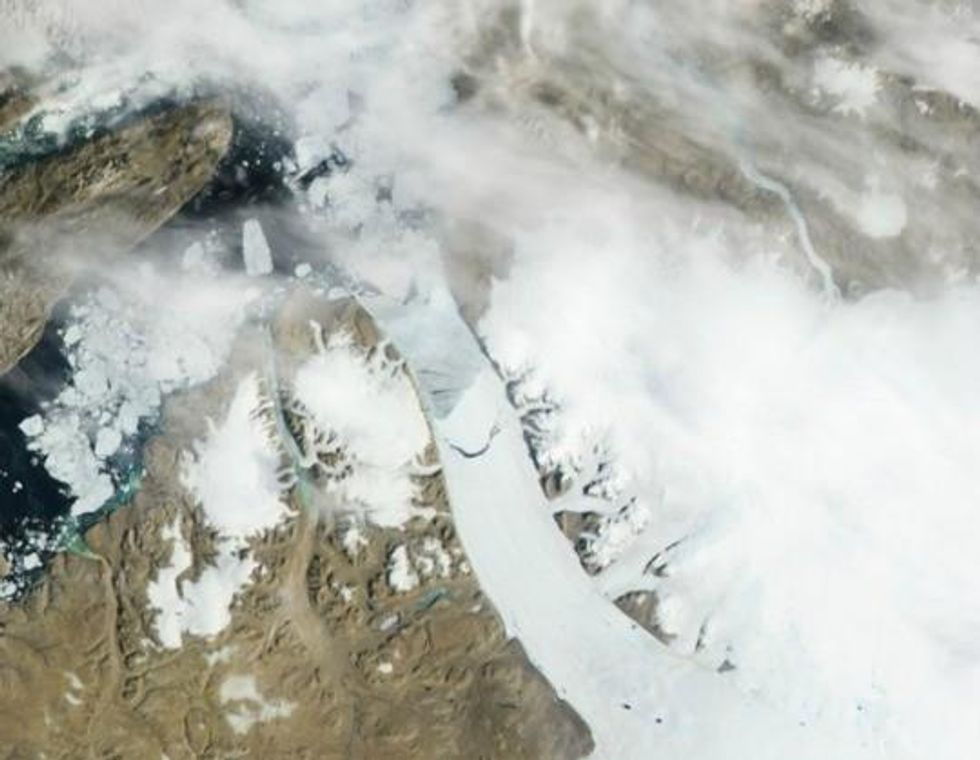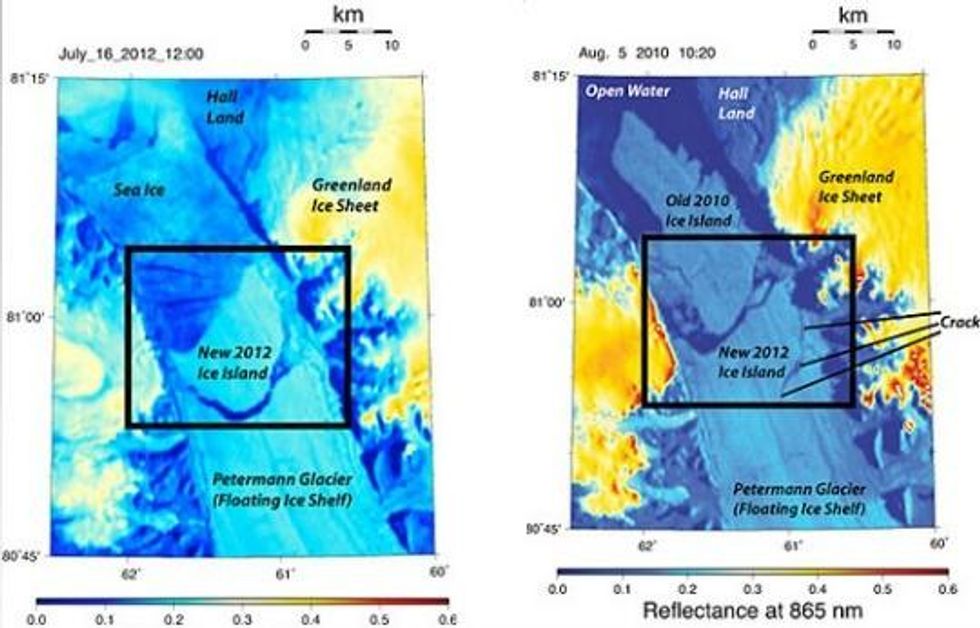

SUBSCRIBE TO OUR FREE NEWSLETTER
Daily news & progressive opinion—funded by the people, not the corporations—delivered straight to your inbox.
5
#000000
#FFFFFF
To donate by check, phone, or other method, see our More Ways to Give page.


Daily news & progressive opinion—funded by the people, not the corporations—delivered straight to your inbox.

A massive iceberg twice the size of Manhattan has broken off one of Greenland's major glaciers -- a development which scientists say is due to alarming warming in the region.
The iceberg, measuring 46 square miles, is the second of its nature to break from Greenland in just two years. In 2010 an iceberg twice its size, one of the largest ever recorded in Greenland, broke free.
"It's dramatic. It's disturbing," said University of Delaware professor Andreas Muenchow, one of the first researchers to notice the break. "We have data for 150 years and we see changes that we have not seen before. It's one of the manifestations that Greenland is changing very fast."
"This is not part of natural variations anymore," said NASA glaciologist Eric Rignot, referring to the vast changes the glacier has seen in the past three years.
Scientists are concerned about rising sea levels due to melting ice in the north. The Arctic had the largest sea ice loss on record for June, scientists reported this week, and Northern Greenland and Canada are warming five times faster than the average global temperature.
"The Greenland ice sheet as a whole is shrinking, melting and reducing in size as the result of globally changing air and ocean temperatures and associated changes in circulation patterns in both the ocean and atmosphere," stated Muenchow.

Left: the new ice island. Right: the ice island that calved from Petermann Glacier in 2010. The crack that led to the 2012 calving also is clearly visible. Courtesy of Andreas Muenchow, University of Delaware. (MongaBay)
Dear Common Dreams reader, The U.S. is on a fast track to authoritarianism like nothing I've ever seen. Meanwhile, corporate news outlets are utterly capitulating to Trump, twisting their coverage to avoid drawing his ire while lining up to stuff cash in his pockets. That's why I believe that Common Dreams is doing the best and most consequential reporting that we've ever done. Our small but mighty team is a progressive reporting powerhouse, covering the news every day that the corporate media never will. Our mission has always been simple: To inform. To inspire. And to ignite change for the common good. Now here's the key piece that I want all our readers to understand: None of this would be possible without your financial support. That's not just some fundraising cliche. It's the absolute and literal truth. We don't accept corporate advertising and never will. We don't have a paywall because we don't think people should be blocked from critical news based on their ability to pay. Everything we do is funded by the donations of readers like you. Will you donate now to help power the nonprofit, independent reporting of Common Dreams? Thank you for being a vital member of our community. Together, we can keep independent journalism alive when it’s needed most. - Craig Brown, Co-founder |

A massive iceberg twice the size of Manhattan has broken off one of Greenland's major glaciers -- a development which scientists say is due to alarming warming in the region.
The iceberg, measuring 46 square miles, is the second of its nature to break from Greenland in just two years. In 2010 an iceberg twice its size, one of the largest ever recorded in Greenland, broke free.
"It's dramatic. It's disturbing," said University of Delaware professor Andreas Muenchow, one of the first researchers to notice the break. "We have data for 150 years and we see changes that we have not seen before. It's one of the manifestations that Greenland is changing very fast."
"This is not part of natural variations anymore," said NASA glaciologist Eric Rignot, referring to the vast changes the glacier has seen in the past three years.
Scientists are concerned about rising sea levels due to melting ice in the north. The Arctic had the largest sea ice loss on record for June, scientists reported this week, and Northern Greenland and Canada are warming five times faster than the average global temperature.
"The Greenland ice sheet as a whole is shrinking, melting and reducing in size as the result of globally changing air and ocean temperatures and associated changes in circulation patterns in both the ocean and atmosphere," stated Muenchow.

Left: the new ice island. Right: the ice island that calved from Petermann Glacier in 2010. The crack that led to the 2012 calving also is clearly visible. Courtesy of Andreas Muenchow, University of Delaware. (MongaBay)

A massive iceberg twice the size of Manhattan has broken off one of Greenland's major glaciers -- a development which scientists say is due to alarming warming in the region.
The iceberg, measuring 46 square miles, is the second of its nature to break from Greenland in just two years. In 2010 an iceberg twice its size, one of the largest ever recorded in Greenland, broke free.
"It's dramatic. It's disturbing," said University of Delaware professor Andreas Muenchow, one of the first researchers to notice the break. "We have data for 150 years and we see changes that we have not seen before. It's one of the manifestations that Greenland is changing very fast."
"This is not part of natural variations anymore," said NASA glaciologist Eric Rignot, referring to the vast changes the glacier has seen in the past three years.
Scientists are concerned about rising sea levels due to melting ice in the north. The Arctic had the largest sea ice loss on record for June, scientists reported this week, and Northern Greenland and Canada are warming five times faster than the average global temperature.
"The Greenland ice sheet as a whole is shrinking, melting and reducing in size as the result of globally changing air and ocean temperatures and associated changes in circulation patterns in both the ocean and atmosphere," stated Muenchow.

Left: the new ice island. Right: the ice island that calved from Petermann Glacier in 2010. The crack that led to the 2012 calving also is clearly visible. Courtesy of Andreas Muenchow, University of Delaware. (MongaBay)